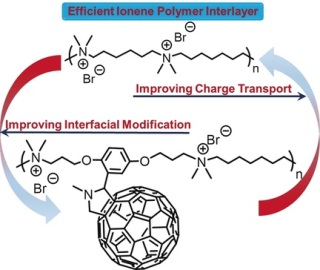Mar 28 2019
Organic photovoltaics have realized extraordinarily high efficiencies, but discovering ideal combinations of materials for high-performance organic solar cells, which are also economically competitive, still poses a challenge. Scientists from the United States and China have currently created a groundbreaking interlayer material to enhance electrode performance and device stability. In the journal Angewandte Chemie, the researchers explain their fullerene-spiked, easily processable ionene polymer, which enhances the power conversion proficiency of organic solar cells.
 ©Wiley-VCH
©Wiley-VCH
In contrast to typical silicon-based solar cells, organic photovoltaics (OPVs) include organic molecules in solar power generation. Materials in OPVs are plentiful and processable, inexpensive and lightweight, and the modules can be made bendable and with modifiable properties. The huge drawback of such materials is that attaining longevity and high performance necessitates intricate settings and architectures. Improved blends of materials that match the electrodes remain indefinable.
Gold or silver metals form air-stable, processable cathodes, but they also lower the potential of the device. To resolve this issue, Yao Lui at Beijing University of Chemical Technology (China), and Thomas Russell and Todd Emrick at the University of Massachusetts, Amherst (USA), and their research groups, have created an innovative polymeric material to act as an interlayer between the active layer and the electrode. This interlayer should be conductive and should lower the work function of the cathode by making an interfacial dipole.
As an interlayer material, the scientists examined a novel group of charged polymers, the ionene polymers. “Ionene polymers are polycations in which the charged moieties are positioned within the polymer backbone rather than as pendant groups,” the researchers explain. This results in a higher charge distribution than in conventional cationic polymers, and besides, improved tunability. Ionene polymers offer a beneficial interfacial dipole, but alone, they lack the needed conductivity.
Thus, the researchers added fullerenes in the structural framework of the polymer layer. So-called “bucky balls”—fullerene spheres composed exclusively from carbon—are already employed as common acceptor molecules in OPV devices. They are very conductive and have many other advantageous properties.
The researchers readied the fullerene–ionene interlayer material by transforming the conventional step-growth polymerization chemistry with novel, functional monomers. They assembled the OPV devices and added an interlayer. The outcome was a remarkable increase in power conversion efficiency—on average three-fold—when likened to devices without the interlayer. Efficiencies of more than 10% point to additional applicability of these modular devices.
This work reveals that a comparatively simple alteration to the composition of materials can enhance the efficiency in organic electronics and can overcome inherent issues associated with the combination of soft (active-layered) materials and hard (electrodes).